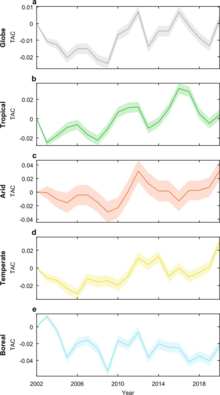A complex system is a system composed of many components which may interact with each other. Examples of complex systems are Earth's global climate, organisms, the human brain, infrastructure such as power grid, transportation or communication systems, complex software and electronic systems, social and economic organizations, an ecosystem, a living cell, and ultimately the entire universe.

Mutualism describes the ecological interaction between two or more species where each species has a net benefit. Mutualism is a common type of ecological interaction, one that can come from a parasitic interaction. Prominent examples include most vascular plants engaged in mutualistic interactions with mycorrhizae, flowering plants being pollinated by animals, vascular plants being dispersed by animals, and corals with zooxanthellae, among many others. Mutualism can be contrasted with interspecific competition, in which each species experiences reduced fitness, and exploitation, or parasitism, in which one species benefits at the expense of the other.
Regime shifts are large, abrupt, persistent changes in the structure and function of ecosystems, the climate, financial systems or other complex systems. A regime is a characteristic behaviour of a system which is maintained by mutually reinforced processes or feedbacks. Regimes are considered persistent relative to the time period over which the shift occurs. The change of regimes, or the shift, usually occurs when a smooth change in an internal process (feedback) or a single disturbance triggers a completely different system behavior. Although such non-linear changes have been widely studied in different disciplines ranging from atoms to climate dynamics, regime shifts have gained importance in ecology because they can substantially affect the flow of ecosystem services that societies rely upon, such as provision of food, clean water or climate regulation. Moreover, regime shift occurrence is expected to increase as human influence on the planet increases – the Anthropocene – including current trends on human induced climate change and biodiversity loss. When regime shifts are associated with a critical or bifurcation point, they may also be referred to as critical transitions.
Patch dynamics is an ecological perspective that the structure, function, and dynamics of ecological systems can be understood through studying their interactive patches. Patch dynamics, as a term, may also refer to the spatiotemporal changes within and among patches that make up a landscape. Patch dynamics is ubiquitous in terrestrial and aquatic systems across organizational levels and spatial scales. From a patch dynamics perspective, populations, communities, ecosystems, and landscapes may all be studied effectively as mosaics of patches that differ in size, shape, composition, history, and boundary characteristics.

In ecology, resilience is the capacity of an ecosystem to respond to a perturbation or disturbance by resisting damage and subsequently recovering. Such perturbations and disturbances can include stochastic events such as fires, flooding, windstorms, insect population explosions, and human activities such as deforestation, fracking of the ground for oil extraction, pesticide sprayed in soil, and the introduction of exotic plant or animal species. Disturbances of sufficient magnitude or duration can profoundly affect an ecosystem and may force an ecosystem to reach a threshold beyond which a different regime of processes and structures predominates. When such thresholds are associated with a critical or bifurcation point, these regime shifts may also be referred to as critical transitions.
The Ramon Margalef Prize in Ecology is a prize awarded annually by the Generalitat de Catalunya to recognize an exceptional scientific career or discovery in the field of ecology or other environmental sciences. The award was created to honor the life and work of Ramon Margalef. The award has been presented every year since 2004 and comes with an honorarium of €80,000 and a sculpture representing a microalga, called Picarola margalefii. It is open to ecologists from anywhere in the world.
Ecological threshold is the point at which a relatively small change or disturbance in external conditions causes a rapid change in an ecosystem. When an ecological threshold has been passed, the ecosystem may no longer be able to return to its state by means of its inherent resilience. Crossing an ecological threshold often leads to rapid change of ecosystem health. Ecological threshold represent a non-linearity of the responses in ecological or biological systems to pressures caused by human activities or natural processes. Critical load, regime shift, critical transition and tipping point are examples of other closely related terms.

In climate science, a tipping point is a critical threshold that, when crossed, leads to large, accelerating and often irreversible changes in the climate system. If tipping points are crossed, they are likely to have severe impacts on human society and may accelerate global warming. Tipping behavior is found across the climate system, for example in ice sheets, mountain glaciers, circulation patterns in the ocean, in ecosystems, and the atmosphere. Examples of tipping points include thawing permafrost, which will release methane, a powerful greenhouse gas, or melting ice sheets and glaciers reducing Earth's albedo, which would warm the planet faster.
George Sugihara is currently a professor of biological oceanography in the Physical Oceanography Research Division at the Scripps Institution of Oceanography, where he is the inaugural holder of the McQuown Chair in Natural Science. Sugihara is a theoretical biologist who works across a variety of fields ranging from ecology and landscape ecology, to epidemiology, to genetics, to geoscience and atmospheric science, to quantitative finance and economics.
In ecology, the theory of alternative stable states predicts that ecosystems can exist under multiple "states". These alternative states are non-transitory and therefore considered stable over ecologically-relevant timescales. Ecosystems may transition from one stable state to another, in what is known as a state shift, when perturbed. Due to ecological feedbacks, ecosystems display resistance to state shifts and therefore tend to remain in one state unless perturbations are large enough. Multiple states may persist under equal environmental conditions, a phenomenon known as hysteresis. Alternative stable state theory suggests that discrete states are separated by ecological thresholds, in contrast to ecosystems which change smoothly and continuously along an environmental gradient.

Planetary boundaries are a framework to describe limits to the impacts of human activities on the Earth system. Beyond these limits, the environment may not be able to self-regulate anymore. This would mean the Earth system would leave the period of stability of the Holocene, in which human society developed. The framework is based on scientific evidence that human actions, especially those of industrialized societies since the Industrial Revolution, have become the main driver of global environmental change. According to the framework, "transgressing one or more planetary boundaries may be deleterious or even catastrophic due to the risk of crossing thresholds that will trigger non-linear, abrupt environmental change within continental-scale to planetary-scale systems."
Environmental anthropology is a sub-discipline of anthropology that examines the complex relationships between humans and the environments which they inhabit. This takes many shapes and forms, whether it be examining the hunting/gathering patterns of humans tens of thousands of years ago, archaeological investigations of early agriculturalists and their impact on deforestation or soil erosion, or how modern human societies are adapting to climate change and other anthropogenic environmental issues. This sub-field of anthropology developed in the 1960s from cultural ecology as anthropologists borrowed methods and terminology from growing developments in ecology and applied then to understand human cultures.

Carl Folke, is a trans-disciplinary environmental scientist and a member of the Royal Swedish Academy of Sciences. He is a specialist in economics, resilience, and social-ecological systems, viewing such systems as intertwined and potentially unexpected in their interactions. As a framework for resource management, this perspective brings important insights to environmental management, urban planning, and climate adaptation. He suggests ways to improve our ability to understand complex social-ecological interactions, deal with change, and build resilience, often working at smaller scales as a step towards addressing larger scales.
Climate resilience is defined as the "capacity of social, economic and ecosystems to cope with a hazardous event or trend or disturbance". This is done by "responding or reorganising in ways that maintain their essential function, identity and structure while also maintaining the capacity for adaptation, learning and transformation". The key focus of increasing climate resilience is to reduce the climate vulnerability that communities, states, and countries currently have with regards to the many effects of climate change. Efforts to build climate resilience encompass social, economic, technological, and political strategies that are being implemented at all scales of society. From local community action to global treaties, addressing climate resilience is becoming a priority, although it could be argued that a significant amount of the theory has yet to be translated into practice.

Marten Scheffer is a Dutch ecologist, mathematical biologist and professor of Aquatic Ecology and Water Quality Management at Wageningen University and Research Centre. He was a winner of the 2009 Spinoza Prize. His research focuses on complex systems and their adaptability.

The Stockholm Resilience Centre (SRC), is a research centre on resilience and sustainability science at Stockholm University. It is a joint initiative between Stockholm University and the Beijer Institute of Ecological Economics at the Royal Swedish Academy of Sciences.

An ecosystem, short for ecological system, is defined as a collection of interacting organisms within a biophysical environment. Ecosystems are never static, and are continually subject to stabilizing and destabilizing processes alike. Stabilizing processes allow ecosystems to adequately respond to destabilizing changes, or pertubations, in ecological conditions, or to recover from degradation induced by them: yet, if destabilizing processes become strong enough or fast enough to cross a critical threshold within that ecosystem, often described as an ecological 'tipping point', then an ecosystem collapse occurs.
Anthony David Barnosky is an ecologist, geologist and biologist (paleoecology). He was Professor at the Department of Integrative Biology at UC Berkeley until his retirement. His research is concerned with the relationship between climate change and mass extinctions.
Jordi Bascompte is a professor of ecology at the University of Zurich and the director of its specialized master's program on quantitative environmental sciences. He is best known for having brought the interactions of mutual benefit between plants and animals into community ecology, at the time largely dominated by predation and competition. His application of network theory to the study of mutualism has identified general laws that determine the way in which species interactions shape biodiversity.

In mathematical modeling, resilience refers to the ability of a dynamical system to recover from perturbations and return to its original stable steady state. It is a measure of the stability and robustness of a system in the face of changes or disturbances. If a system is not resilient enough, it is more susceptible to perturbations and can more easily undergo a critical transition. A common analogy used to explain the concept of resilience of an equilibrium is one of a ball in a valley. A resilient steady state corresponds to a ball in a deep valley, so any push or perturbation will very quickly lead the ball to return to the resting point where it started. On the other hand, a less resilient steady state corresponds to a ball in a shallow valley, so the ball will take a much longer time to return to the equilibrium after a perturbation.











